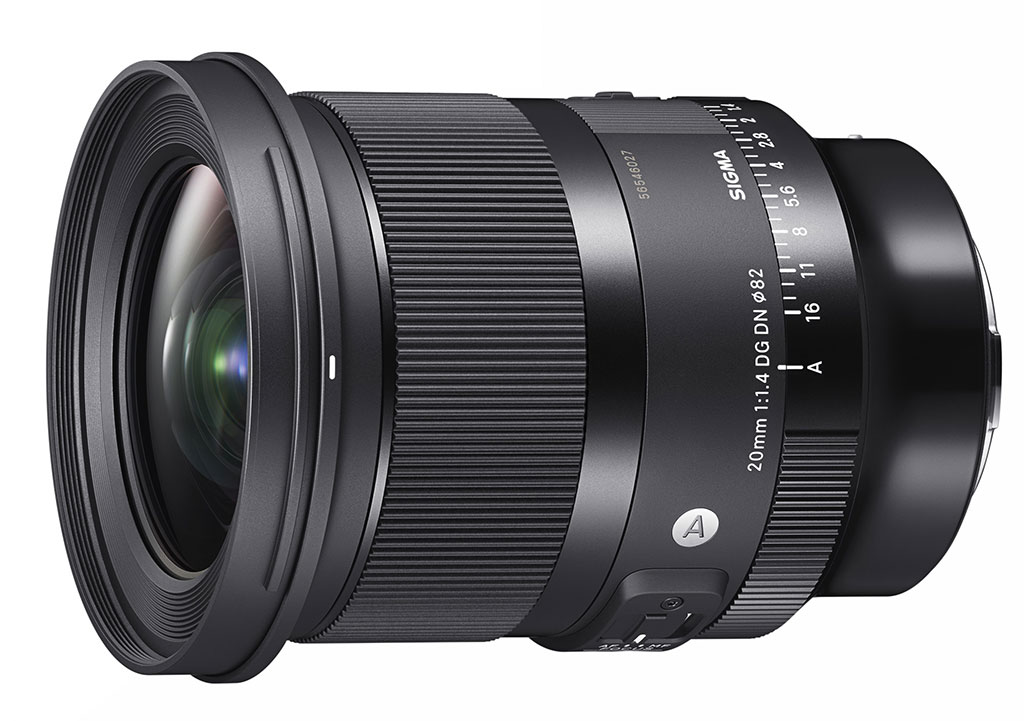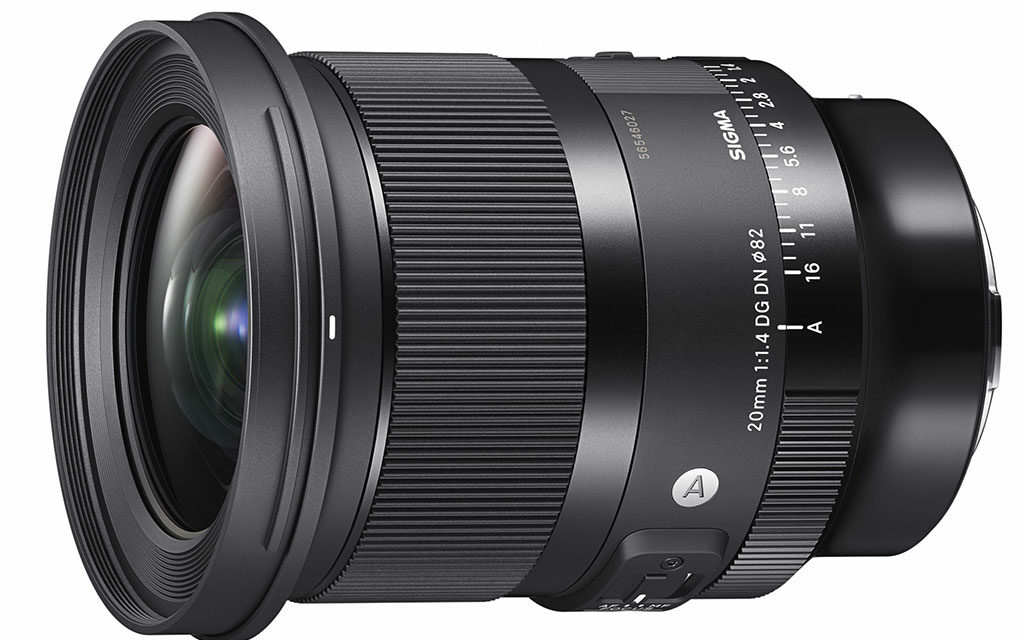
Sigma last year launched two wide-angle prime lenses for Sony E-mount and Leica/Panasonic/Sigma L-Mount full-frame mirrorless cameras, the Sigma 20mm F1.4 DG DN Art and the Sigma 24mm F1.4 DG DN Art. The 20mm prime is particularly noteworthy since it’s a somewhat unusual lens. Except for the Sigma 20mm F1.4 DG HSM Art for DSLR cameras, the Sigma 20mm F1.4 DG DN Art for mirrorless is the only 20mm F1.4 lens available for full-frame cameras.
Nobody else makes a lens like this, including Canon, Nikon and Sony. There are 20mm F1.8 lenses but no 20mm F1.4 lenses. One of the most surprising things about this unique lens is that it retails for just $899. Read my hands-on review of the Sigma 20mm F1.4 DG DN Art lens below.
Design & Usability
The Sigma 20mm F1.4 DG DN Art, like many of Sigma’s other Art series lenses, is an attractive lens with its varying black materials, including some flat surfaces and some with a bit more gloss. In the case of the shinier surfaces, they do a good job repelling fingerprints, which is nice. The lens is built using Sigma’s Thermally Stable Composite (TSC), a type of polycarbonate that behaves thermally like aluminum. The lens “feels” like metal to me. In terms of materials, it’s a high-quality lens.
It is a relatively large lens at 4.4 inches long with a maximum diameter of 3.5 inches. It’s worth noting that the max diameter is localized to the very front of the lens so that it can accept 82mm filters without a noticeable vignette. The rest of the lens is narrower and especially narrow near the lens mount. It weighs 1.4 pounds, which is heavy for a wide-angle prime lens. That said, the lens balances very nicely on the Sony a7R IV camera that I used to test it and is extremely easy to shoot handheld for extended periods.
The lens includes many switches on the barrel, all of which provide satisfying tactile feedback, including a new MFL switch, which allows you to lock manual focus so that if you accidentally move the large focus ring, your focus won’t change. Focus-by-wire lenses don’t generally offer great manual focusing experiences, but this lens is an exception. There’s an AF/MF switch, an aperture ring de-click switch, an aperture ring lock switch and a function button.
Speaking of the aperture ring, it’s nice. It includes aperture markings at full stops from F1.4 to F16 and dashes for each one-third aperture setting. There’s also an “A” setting that allows you to adjust the aperture using your camera’s dials or let the aperture be controlled automatically.
The lens comes with a high-quality petal-type lens hood. It includes multiple materials, including one with a grippy surface to make it easier to rotate the hood on and off the lens barrel. It includes a lock button, too. A slot to rotate a polarizing filter more easily would be a nice improvement, but otherwise, it’s a good, functional lens hood. The lens also comes with a rectangular case. It’s not a hard case but also a lot more than a pouch. The soft case includes padding and a custom insert for the lens. It’s always nice to see lenses come with good cases, especially when they cost under $1,000.
Overall, the Sigma 20mm F1.4 DG DN Art has excellent build quality and design. The weather-resistant lens seems poised to withstand the elements and last photographers a long time. It feels nice in the hands, and its generously sized focus ring works well, offering a good amount of resistance to make focusing precise and rewarding. Sigma’s design team always does good work, and the new 20mm F1.4 Art lens is no exception.

Sony A7R IV, Sigma 20mm F1.4 DG DN Art. Exposure: 1/6 sec., ƒ/11, ISO 100.
Image Quality
The Sigma 20mm F1.4 DG DN Art includes 17 elements in 15 groups, with two SLD elements and three aspherical lens elements. Among the three aspherical elements is the largest double-sided aspherical element Sigma has ever used in one of its lenses.
The lens is sharp, especially when you stop down. It’s pretty good at ƒ/1.4, but I did notice a bit of softness overall, even in the center of the frame. Granted, this is noticeable only when “pixel peeping.” Images look sharp when viewed at normal sizes or even reasonably large prints.
If you want to improve sharpness, all you must do is stop down to ƒ/2. The image is noticeably sharper in the center of the frame at this aperture. Corner performance improves some, too, although it’s not as big of an improvement.
At ƒ/2.8, the lens is sharper still. At this aperture, the lens has achieved optimal performance, so far as I can tell. The corner performance is a bit better, though still not especially great, but that’s not surprising for a 20mm prime lens. Is performance better at ƒ/4 than at ƒ/2.8? If so, it’s by a very thin margin. You’re splitting hairs to see much difference between the image quality at ƒ/2.8 and ƒ/4.
Of course, there’s more to image quality than sharpness. The Sigma 20mm F1.4 DG DN Art lens does a great job at controlling aberrations. While there’s some minor purple fringing around high-contrast areas, it’s barely noticeable. The lens also performs well regarding distortion and vignette.
The lens features an 11-blade rounded aperture diaphragm. The resulting bokeh is very nice. Even though it’s a wide-angle lens and you don’t often worry about bokeh, it’s also an ƒ/1.4 lens. Out-of-focus elements are rendered softly, and bokeh has no ugly, distracting elements.

Sony A7R IV, Sigma 20mm F1.4 DG DN Art. Exposure: 1/800 sec., ƒ/2.8, ISO 100.
Autofocus Performance
The Sigma 20mm F1.4 DG DN Art includes a stepping motor and is an internally focusing lens. The autofocus speed and accuracy are excellent. The lens is also pretty quiet when focusing, although you can occasionally hear a subtle buzzing.
The E-mount version that I used is compatible with Sony’s fancy autofocus modes, including DMF, AF+MF and AF Assist. In terms of manual focus, I’ve already mentioned the MFL lock switch, which is great. As for minimum focusing distance, the lens can focus as close as 9.1 inches, resulting in a max magnification ratio of 1:6.1. It’s a far cry from a macro lens, but it can focus on very close foreground subjects for landscape photography.
There’s a lot to like about the Sigma 20mm F1.4 DG DN Art lens and very little to dislike. The lens isn’t especially sharp when shot wide-open, but stopping down even slightly helps a lot. Overall, it offers a unique combination of an ultra-wide-angle field of view and fast maximum aperture. To offer this compelling combination at $899 is very impressive.
Jeremy Gray is the reviews editor of our sibling website Imaging Resource. Read an extended version of this review and check out additional sample images at imaging-resource.com.
The post Sigma 20mm F1.4 DG DN Art Lens Review appeared first on Outdoor Photographer.
















